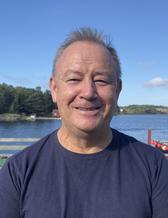In recent years it has become more difficult to find blue mussels on the west coast of Sweden. Now a new project will dig deeper into the subject.
- We are interested to see how the mussels fare in different environments, says Mats Lindegart, professor at the Department of marine sciences.
It has become more difficult for crabfishing children to find blue mussels as bait. However, it is still unclear whether the blue mussel have decreased generally, says Mats Lindegart.
- Actually, we have poor data on the historical distribution of mussels.
Recent research however established that blue mussels have declined in natural environments such as seabeds, while thriving in farms and on artificial environments such as piers. Whether the species has decreased depends on when in time it is compared with, however according to personal anecdotes it was better in the past.
- The general picture seems to be that mussels have decreased and I do believe so as well. However we don't know if people remember the mussels when they were most abundant - were there more mussels in general or were there only a lot of mussels in certain areas?
Measurement of blue mussel habitats

The lack of data is something Mats Lindegart hopes the new project Blue mussels - interactions between stocks in natural and artificial environments (Blåmusslor - interaktioner mellan bestånd i naturliga och artificiella miljöer ) will solve.
- We are interested to see how the mussels fare in different environments. Are there equal numbers of mussels recruited in the different environments and do survival rates differ?
Due to this, the scientists will examine areas such as natural soft bottoms, hard bottom environments, artificial structures and mussel cultivations. Initially, the most vulnerable life stage of the blue mussel is examined.
- Then one can get a better grip on whether it is the juvenile mussels that are suffering or whether it is the older mussels that have a high mortality rate.
Mats Lindegart himself believes that it has to do with the earlier stages.
- Either there are no larvae or the larvae die, are eaten or die for other reasons.
Investigations and experiments
Within the project, population sizes will also be estimated. To do this, Mats Lindegart wants the help of the public, as people often refer to the amount of mussels they experienced when they were young.
- I would like to gather information of the public, where they can more precisely say when and where they saw the blue mussels, so that I can get a better overall picture of the distribution of mussels.
At the moment is the planning for the summers experiments on mussel larvae, such as plankton samples, taking place. Together with further research, they will form the basis for a future comprehensive picture of Swedish coastal mussel populations.
- We have been involved in the gathering of data on the presence of larvae with help from mussels farmers, The Swedish Meteorological and Hydrological Institute and the Food Safety Authority, says Mats Lindegart.
Text: Kajsa Centre






